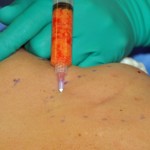
Fat injection reconstruction, also known as lipofilling uses suctioned fat from the abdomen which is then concentrated prior to injection into the breast. Because the harvested fat contains a fair number of stem cells, it is theorized that it can have a stimulatory effect on the recipient breast. While this is hopefully beneficial to help the fat graft survive and maintain volume, it is also theoretically possible that this stimulation may cause a recurrence of the breast cancer or promote one de novo. While this is believed to be very unlikely, there is little evidence to come to a conclusion either way.
A recently published study in the Annals of Oncology provides some insight into whether breast reconstruction with fat injections is safe. In this clinical study out of Italy, conducted over ten years from 1997 to 2008, evaluated 321 women who had fat injections as part of their breast reconstruction. These were compared to over 600 women who had breast reconstruction without fat grafting. The incidence of a local breast cancer recurrence after reconstruction was eight women in the fat injection group (2.4%) and 19 women in the non-fat injected group. (2.9%)
The value of this study is that it is the first to look at the differences in breast cancer resurrence after fat injection grafting. While these results show that a stimulary effect on potential cancer cells does not appear to exist from the fat grafts, as judged by any differences in recurrence rates, it is far from an absolute certainty. Comforting yes but studies from other institutions are needed for confirmation.
For now, fat injection as part of breast reconstruction appears safe and patients should have no fear about its use. The value of transplanted fat, particularly into breasts that have received radiation, can really be useful to improve small defects and asymmetries after an initial flap reconstruction.
Dr. Barry Eppley
Indianapolis, Indiana


